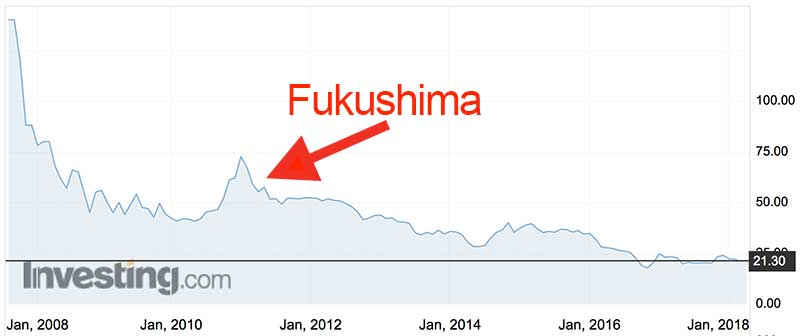Why uranium could soon be on the boil and which stocks might benefit
Mining
Mining
Uranium prices could soon be on the boil again — and here are two ASX stocks that could benefit, writes Barry FitzGerald in his weekly Garimpeiro column
Uranium has been the world’s worst performed commodity.
It’s essentially been on the skids since 2007 when the spot price peaked at $US143/lb, and it was last quoted at a miserable 15-year low of $US21/lb. (See graph below).
It is a price at which much — if not all — of the global industry loses money.
Only higher-priced contract sales — under which the bulk of the world’s uranium is sold — have kept the uranium industry afloat.
But signs are emerging that the worst is over for a commodity that fuels as much as 10 per cent of the world’s electricity needs with “green’’ credentials to boot.
Against that backdrop, early positioning by straw-hats-in-winter investors in ASX uranium stocks is underway.
Should prices for the nuclear fuel take off as many suspect, they could be in line for some explosive share price growth.
Having said that though, there have been false downs for uranium in the past.
Things were okay for the industry in early 2011 when spot prices were $US67/lb.
But on March 11 that year, a monster tsunami triggered by an earthquake hit the Fukushima power plant in Japan.
This graph shows Fukushima’s impact on the price of uranium:

The disaster was a major setback for uranium demand. Japan’s fleet of power plants was a big consumer — and most have yet to be restarted.
Nuclear power’s much-vaunted role in providing zero-emission power to a world increasingly worried about carbon emissions was also challenged.
The case for uranium is building
Still, the case for a brighter future for nuclear power/uranium is building, prompting investors to stir in a sector that has struggled to find friends since Fukushima.
Canadian uranium heavyweight Cameco – it accounts for 16 per cent of global production from mines in Canada and Kazakhstan – took up uranium’s cause at its recent investor briefing for its March quarter results.
President and CEO Tim Gitzel said Cameco was “more optimistic than we were a year ago’’ on the outlook for uranium.
“Today, there are 55 reactors under construction, the majority of which will be online over the next several years and 14 of which are expected to start this year. And of course growth in reactor construction will translate to increased uranium demand which will require new production going forward,’’ Gitzel said.
“We really should be thinking about that now. Unfortunately prices that start with a two are still nowhere near, not even close to the levels needed as we are increasingly seeking to sustain existing production levels and to encourage investment in future supply.’’
Gitzel said that was why he believed sentiment would swing uranium’s way at some point this year to deliver the sort of long-term contract prices needed to ensure long-run global supply requirements are met.
ASX-listed uranium stocks
Whether the early stirrings in the uranium market can save ASX-listed Paladin Energy (ASX:PDN) from having to place its Langer Heinrich uranium operation on care and maintenance in coming months remains to be seen.
What is more certain is that the stirring investor interest is in pre-development uranium stocks which don’t come with the sort of baggage which saw creditors to Paladin end up owning 98 per cent of its stock under a debt restructuring.
Two uranium pre-developers that are on investor’s radars in the expectation of better days ahead for uranium prices are Boss Resources (ASX:BOE) and Vimy Resources (ASX:VMY), the latter previously mentioned here on February 1.
Reflecting the renewed interest in the uranium developers, Boss has just pulled in $8 million from a share placement to fund a study into returning its Honeymoon uranium project in South Australia to production.
Vimy has raised $6 million from a placement for an aggressive exploration push at its recently acquired Alligator River exploration portfolio in the Northern Territory.
In both cases, the incoming investors are seeking leveraged returns to the thematic that uranium prices could soon be on the boil again.